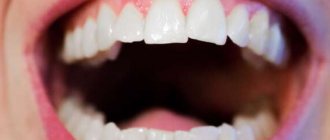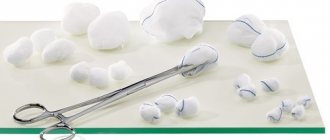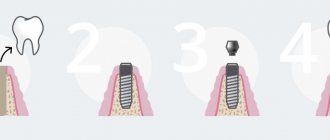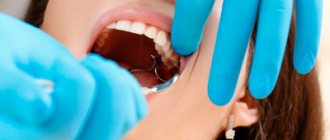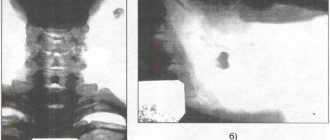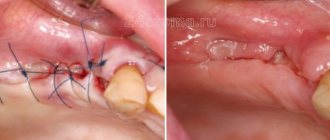Removal or extraction of a diseased tooth is a surgical procedure, after which it is necessary to carefully monitor the condition of the gums at the site of intervention. After the procedure has been carried out, it is necessary to place a special turunda into the resulting cavity. To carry out this rather complex procedure, the surgeon’s professionalism alone is not enough, because the postoperative period is quite dangerous if proper care of the affected gum is not carried out at this time. In this case, if the treatment is insufficient, some kind of infection may get into the hole and cause complications.
To avoid any problems with healing, the doctor puts a special medicine in the socket of the extracted tooth. With its help, the wound is protected from infections and external influences. What medicine is put into the hole after tooth extraction? Let's talk about this in the article.
How is the affected tooth removed?
The procedure itself should only be performed by an experienced surgeon and only when other treatment methods can no longer help. There are a number of reasons that can trigger the removal of an affected tooth:
- if the crown of the tooth is completely destroyed;
- when the patient is indicated for prosthetics;
- if complications arise during the eruption of a wisdom tooth;
- if filling requires perforation of the root canal.
Important ! There are cases when there is every reason to remove a tooth, but the patient has contraindications to this. In such cases, most often the intervention is carried out within the walls of a hospital with subsequent monitoring of the patient’s condition.
There are a number of main contraindications to surgical tooth extraction. These include:
- previous heart attacks;
- high blood pressure;
- arrhythmia;
- blood diseases;
- mental problems or neurological diseases.
If no contraindications have been identified in a patient who needs surgical removal of the affected tooth, then he is referred to the procedure itself, which should be carried out according to the following scheme.
| Stage | Description |
| Visit doctor | Before performing the procedure, the doctor must find out whether the patient has allergic reactions to any anesthetics, cardiovascular pathologies, or whether the patient suffers from hypertension. |
| Anesthesia | After all the necessary information has been obtained, the patient is sent for anesthesia. A fairly large number of different means are currently used to remove teeth. Their duration of action is from forty minutes to three hours. |
| Preparation | Next comes preparation for the intervention itself: in order not to injure the gum during manipulation, it first peels off from the tooth bone by at least five millimeters. This procedure is carried out using a special tool. The surgeon places special forceps on the tooth, and then begins to swing the tooth itself with them in order to destroy the ligaments attached to the jaw bone. |
| Removal | The affected tooth itself is pulled out, that is, extraction. After the affected tooth has been removed, the resulting hole must be thoroughly examined. This is necessary so as not to leave tooth fragments or a cyst in the wound cavity. If the extraction of the affected tooth took place in the presence of flux, then after its removal the gums are cut in the right place and the pus is released. After this manipulation, a drainage is inserted into the wound cavity. |
| Treatment | After the procedure is completed, you need to treat the wound itself. If pus is found at the site of the lesion, then in this case the hole must be washed with an antiseptic solution, and then an anti-inflammatory agent should be placed in the wound. If the hole itself is too large after extracting the tooth, then a suture is necessary. |
| Consultation | After the procedure has been completely completed, before discharge, the doctor must instruct the patient in detail on how to care for the hole during the healing period, and also prescribe any medications if necessary. |
After the tooth is removed and before the patient goes home, the doctor inserts a special medicine into the tooth socket. It is necessary to protect the wound from various influences, as well as for faster and more proper healing. Some patients complain that the turunda with the medicine interferes greatly, but this will have to be endured.
Important ! If you remove the turunda ahead of time, serious complications may develop, which will have to be dealt with not only by the dentist, but also by other doctors.
The doctor prescribes exactly the medicine that is safe for every person. True, it does not have the most pleasant taste, but a person will have to ignore this factor if he wants the wound to heal as quickly as possible.
There are exceptional cases when it is simply impossible to remove the affected tooth according to the scheme above. The reason for this may be the following factors:
- if the tooth root is crooked;
- if the bone tissue of the tooth is too fragile;
- if the crown of the affected tooth is already completely destroyed;
- if the figure eight is in a position of incomplete eruption or in a horizontal position.
If a patient who needs tooth extraction has any of these characteristics, then the intervention is performed in a different way. First, the gum is cut and peeled away from the bone. After this, the specialist drills out the desired area using a drill, which creates access to the root of the required tooth.
Important ! In some cases, the partitions between the roots of the tooth are sawed, after which each root is removed one by one.
After such procedures, healing is more difficult and longer. Such an intervention may cause the patient to develop stomatitis. In many cases of such intervention, a secondary infection is attached to the affected area.
However, no matter which tooth is removed, medicine must be placed in the hole. This procedure is required.
How long can you walk with a temporary filling? 3 determining factors
A temporary filling, unlike a conditionally permanent filling, is less durable. It is installed for a short period of time. But only a doctor can say exactly how long to walk with a temporary filling. The period differs in individual situations. Much also depends on the patient.
How long does it take to place a temporary filling for various diseases?
Let's start with why a temporary filling is needed in the first place. Why not immediately install a good one for a year? Contrary to popular belief, a filling is not only used at the final stage. The dentist also places it during the treatment process.
- Additional diagnostics. Any doctor will strive to preserve the nerve of the tooth. Therefore, if there is a possibility that the lesion has not affected it, then the nerve is left intact. It is temporarily closed with a filling after treating the source of inflammation. If the tooth continues to hurt, the nerve is removed and a permanent filling is installed in place of the temporary one. How long will it take to wear a temporary filling in this case? About a week.
- Drugs. The filling can also cover the tooth tissue while the drug is absorbed. It prevents the entry of bacteria and the development of infections. You will have to walk with a temporary filling for 5-14 days.
- In case of inflammation of the roots, fillings are placed for up to 3 weeks.
- You can walk with a temporary filling for up to several months. This is usually necessary when the patient cannot visit the doctor in the near future. Long-term treatment with fillings is also necessary for cysts and granulomas.
The material determines how long you can walk with a temporary filling
After the examination, the doctor determines the treatment method and how long to walk with a temporary filling. According to this, he selects the material. The compositions differ in their strength.
- Dentin is used for the shortest possible time. The material is quite cheap, but short-lived and unaesthetic. In just a week, the filling wears off by several mm. And light white color rarely matches the natural shade of teeth.
- Cements. You can walk with a temporary cement filling for longer, up to 2 months. The material also stands out against the teeth due to its light color.
- Light-curing material is used for permanent fillings. But it is also suitable for temporary ones. It is worth understanding that if a doctor installed a filling as temporary, this does not mean that the next doctor’s visit can be skipped or postponed. The filling must be replaced on time.
How does a patient influence how long to walk with a temporary filling?
The patient's attitude towards the filling affects its service life. Although the filling is installed only temporarily, it is not worth the risk. Neglect will cause the filling to fall out, wear off, or crack. I'll have to make an appointment with the dentist again. And, what is much worse, pain, inflammation and infections will appear. To extend the life of a temporary filling:
- Use a soft brush
- Avoid sticky and viscous foods (chewing gum, toffee, nougat)
- Don't chew hard objects
- Don't use bleach
In general, you can walk with a temporary filling from 1 day to several months. Only a dentist can say for sure.
What should the patient do after the procedure?
After the procedure has been completed, the specialist must carefully explain to the patient his next steps, as well as the rules for caring for the wound during the healing period.
- The turunda or cotton wool that was left by the surgeon in the hole does not need to be removed by yourself. If the tampon placed by the doctor falls out ahead of schedule, the patient must return to the specialist to install a new turunda. If this is not done, an infection may enter the wound cavity.
- If after the procedure the cheek is very swollen, you can apply ice or a cold compress to it. After this procedure, it is forbidden to heat the affected area and apply hot compresses.
- You can eat food after tooth extraction only two hours after the procedure. It is recommended to eat only liquid and light foods that do not contain solid pieces.
- A blood clot forms in the hole where the tooth was pulled out. It is prohibited to remove it or touch it. The first time after the procedure, you must brush your teeth with caution and do not use any rinses.
- For 7 days after tooth extraction, it is prohibited to carry out other interventions in the oral cavity.
- During the healing period, it is not recommended to overheat, for example, take a steam bath, and also exercise with caution. It is also strongly recommended to stop drinking alcoholic beverages and smoking cigarettes for two days after the procedure.
- After tooth extraction, pain often occurs at the extraction site. In this case, quite often not only the hole, but the whole head as a whole can hurt. Also, the patient may experience pain while eating, regardless of which side of the teeth he chews on. Experts recommend coping with these problems with the help of painkillers, such as Pentalgin or Tempalgin. In this case, it is advisable to take the drug in combination with Suprastin.
Despite the fact that there is medicine in the hole, a person may still feel pain and some burning. Such unpleasant sensations will have to be ignored.
Important ! If the sensations intensify, it is recommended to consult a doctor again so that he can examine the wound and, if necessary, take action.
Materials for temporary fillings
1. Paste dressings (water dentin, oil dentin). Trade names: Tempfill, Cimpat, Cavit, etc.
The main component is zinc oxide. Harden from a few minutes to 2 hours. It is these materials that most often refer to the dentist’s phrase “you can’t eat for so long after an appointment.” Until the moment of curing, the exaggerated parts of the filling are easily erased by antagonist teeth, so such fillings rarely interfere with the bite. The color is bright white, does not match the color of the tooth, and aesthetically they look unpresentable. You can install such a filling in a few seconds. Another advantage is the low cost of this material. The main disadvantage is low mechanical strength and high abrasion. When worn for a long time (1 week or more), they wear off by several millimeters. If such a filling is not surrounded on all sides by the remaining walls of the tooth, it may fall out.
Such fillings are removed by drilling or ultrasound. The second option is preferable when a temporary filling is installed after taking an impression to make an inlay. Since the surface of the tooth does not change, and the orthopedic design corresponds to the shape of the tooth recorded by the impression at the first visit.
It is not recommended to wear such a filling for more than 1 month. During this period, it loses its shape, adhesion to the tooth decreases (so the likelihood of falling out becomes very high), and the seal is broken (bacteria penetrate between the filling and the tooth, supporting the spread of caries or infection of the root canals).
In Russia, the Septo-pack periodontal dressing is often used as a temporary filling. It is identical in properties to the materials described above, with the exception of color - it is not white, but pink.
2. IRM (Intermediate Restorative Material) - a temporary material widespread abroad, but little used in Russia.
The composition is a polymer-reinforced zinc oxide-eugenol cement. It freezes in a few minutes. Due to the high density, the excess must be sanded off in the dentist’s chair (“it will rub off on its own” is no longer applicable here). Designed for longer wear (from several months to 2 years). White in color, but differs significantly from the tooth, the aesthetics of the filling are low. Removable by drilling.
3. Clip and similar light-curing temporary fillings.
The main advantage is that it can be easily removed in one piece. The main disadvantage is that the seal does not hold (the penetration of bacteria between such a filling and the tooth begins almost immediately). Therefore, it is contraindicated to use it as a monomaterial for temporary fillings. But if you first install a sealing material underneath it, and apply the Clip only on top, then its use is justified. Strength and adhesion to the tooth are low. Designed to be worn from 1 day to 1 month.
4. Glass ionomer material.
This material was developed for permanent fillings, but lost out to composite materials in competition. Its use as a temporary one is quite justified.
It is stronger than all the previous ones, has an anti-carious effect, and is aesthetically more adequate. But more expensive and requires drilling. Suitable for temporary fillings of any duration. An additional advantage of such material is the permissibility of its incomplete removal and the use of deep layers as a ready-made insulating gasket (it prevents additional drilling of healthy tooth tissue and protects the pulp from repeated stress and the risk of pulpitis).
5. Composite light-curing material.
In fact, this is the best permanent filling material. But you can also use it as a temporary one. When impeccable aesthetics (for example, the front surface of an incisor) or maximum strength is required (the tooth is so badly damaged that no other filling will last until the next visit). You cannot walk around with such a composite filling until it falls out, because since it is installed for a certain period, it means that it still needs to be changed. Maybe even using the same material, but done in a different way (with more strict adherence to the rules for installing a permanent filling).
About the medicine
The medicine that is placed in the hole can be applied to a piece of gauze, which is subsequently inserted into the hole. In this case, after a certain amount of time indicated by the doctor, it needs to be taken out. This can be done either independently or during your next visit to the dentist. If this is not done in time, the process of putrefaction may begin, which will greatly complicate the situation. It is also not recommended to take out the gauze ahead of time, since food particles can get into the hole and the tongue can touch it, which will interrupt the healing process and also cause complications.
There is another way to install the medicine - in a hemostatic sponge. It already contains a medicine that helps disinfect the socket cavity and helps stop bleeding. You cannot take this sponge out - it will dissolve on its own. Most often this happens within 1-2 days, but in some cases the sponge may remain in the hole for 5-6 days. There is no need to be afraid of this. As a last resort, you can consult a doctor who will examine the wound and determine whether healing is proceeding normally.
Often the medicine in the sponge is very bitter, and this causes severe discomfort to the person. Unfortunately, nothing can be done about this, since getting rid of the sponge ahead of time is strictly contraindicated. To eliminate bitterness, you can drink sweet tea or juice.
Remember ! No circumstances can influence the ability to remove the medicine from the hole ahead of time. After 3-4 days, the surface of the hole will heal, and you will no longer have to experience discomfort.
People often wonder what kind of medicine is used for these purposes. Sometimes the gauze that is placed in the hole is treated with iodine - this will both disinfect the wound and prevent bleeding. The hemostatic sponge is already treated with a special substance consisting of boric acid, collagen and nitrofural, which helps stop the bleeding and protect the hole from various influences. But most often dentists use Alvozhil.
No other means are used for inserting into the hole.
How long does it take for a hole to heal?
The wound left after tooth extraction has a certain healing pattern.
- After the tooth extraction procedure is completed, the circular ligament located around the crown of the extracted tooth begins to contract.
- A short amount of time after the procedure, you may notice an accumulation of blood in the hole. The resulting clot helps protect the wound from infection or small food particles. Over time, the hole begins to become overgrown with fibrous tissue.
- After a certain amount of time, which depends on the characteristics of the human body, as well as on the correct care of the hole after the procedure, the surface of the wound heals and the affected area of the gum is restored.
- After this, over time, new epithelium grows on the surface of the gum, as well as the development of bone tissue at the site of tooth extraction.
Important ! The normal healing of the hole is facilitated by the medicine that is placed in the hole. Without it, the wound will not heal.
Many patients worry about the healing of the wound that remains after tooth extraction. The doctor must explain to the patient that the wound can heal completely only after two or three weeks, provided that all care rules are followed. If they were nevertheless broken or an infection was still able to penetrate the wound, then with repeated disinfection, complete restoration of the affected area will occur in five months.
What is allowed during the healing period?
- Non-solid semi-liquid food.
- Gentle oral hygiene.
What is prohibited during the healing period?
- Drinking alcohol and smoking cigarettes.
- Drinking liquids with a plastic straw.
- Harsh brushing of teeth in general and especially in the healing area.
- Eating dry and solid food.
- Sudden movements of the cheekbones for one week after the procedure.
Auxiliary medications for tooth extraction
If, after the tooth is removed, any complications begin at the intervention site, then modern pharmaceuticals can cope with them. With the help of various medications, the patient can not only eliminate the resulting secondary complications, but also strengthen his immunity as a whole. Quite often, specialists, to ensure against possible complications, in particular, various inflammations and suppurations, prescribe antibacterial drugs in the postoperative period. At the same time, the patient also needs to strengthen the immune system, which will help the wound heal faster. To do this, doctors prescribe vitamin complexes to the patient. Thus, in addition to the medicine placed in the hole and affecting its healing, the patient is recommended to take other drugs to speed up the process.
If during the procedure the patient was identified with any peculiarities or complications and tooth extraction was not without additional trauma, then a number of medications are prescribed in the postoperative period, since in this case there are additional risks of complications. The main thing is that the patient treats the postoperative period responsibly and does not neglect the doctor’s advice and the medications prescribed to him.
Important ! According to statistics, every third patient who has had a tooth removed needs to take antibiotics.
How do dentists treat the disease?
It is advisable to begin treatment of pulpitis in a timely manner, as this can lead to negative consequences and certain complications, for example, periodontitis. Dentists immediately try to relieve the patient of pain, inflammation, eliminate the infection and gradually restore the functionality of the pulp, if possible.
As soon as a patient with acute pulpitis sees a specialist, an anesthetic is injected into the carious cavity, and an analgesic is taken orally. After a thorough examination of the oral cavity, a treatment method is selected - conservative or surgical.
Conservative treatment - helps to get rid of pain, inflammation with the help of medications and physiological methods of therapy that are aimed at preserving the pulp. In such a situation, a biological method is used. Sometimes the patient undergoes partial removal of the pulp, but its viability remains.
Conservative treatment is considered a one-session treatment in most cases, but it may take several days to resolve the problem. There are such indications for the biological method of therapy as focal pulpitis in the acute stage, exposure of the pulp when the dental crown is broken, chronic fibrous pulpitis, the patient’s age is not more than 29 years, no changes in the area of the apical foramen, there is no possibility of prosthetics, and others.
Conservative therapy includes the following steps:
- Anesthesia.
- Treatment of carious cavity with instruments and medications.
- Degreasing procedures, drying the cavity.
- Applying an insulating gasket to the bottom of the pulp and installing a filling.
It is possible and advisable to treat pulpitis surgically only if conservative treatment is impossible. It involves removing the pulp completely, then filling the canals and, accordingly, the dental crown. This method of therapy is considered the most reliable and is carried out in several visits to a specialist:
- Use of anesthesia.
- Removal of carious tissue from the cavity.
- Protecting the tooth from moisture using a rubber dam.
- Removing pulp from the crown and canals.
- Measuring the length of canals, their processing, expansion and filling.
- Rinsing the canals with antiseptics, applying an antiseptic, then placing a temporary filling.
- Removal of temporary filling and preparation from the canals.
- Rinsing the canals and drying them.
- Filling canals with gutta-percha.
- X-ray examination, which helps to track the correctness of the canal filling.
- Installation of a permanent filling.
Taking antibiotics after the procedure
Dentists quite often resort to antibiotics in the postoperative period, especially after tooth extraction. But not every patient who has undergone tooth extraction requires antibiotics. They are prescribed only in the following cases:
- if the patient experiences inflammatory processes in the gum area;
- if the patient is elderly;
- if complications arise during the operation or features of the anatomy of the teeth are revealed, which contributes to more extensive trauma;
- if the patient has a reduced immune system or suffers from any blood diseases.
This list is not all of the reasons for prescribing antibiotics in the postoperative period, because each individual case has its own characteristics. An experienced dentist will be able to easily determine which patient needs to take medications after tooth extraction. The doctor must determine the duration of administration and dose individually for each case. Most often, the course of taking the drug after tooth extraction lasts from five to seven days. In rare complicated cases, treatment can last up to fifteen days. It is simply impossible to determine the average dose of antibiotics that is needed, since each individual drug has its own individual characteristics.
Important ! It is strongly recommended not to take antibiotics unless prescribed by a doctor.
In addition to antibiotics, your doctor may also prescribe medications to normalize the microflora after taking antibiotics. The most commonly prescribed drug is Linex, but sometimes other drugs from the group of probiotics are also prescribed.
How long does it take for treatment?
How long does it take to treat the disease to get a positive result from therapy? In this situation, everything will depend on many factors. First of all, attention is paid to the stage of the disease and the inflammatory process. The general condition of the patient and other severe symptoms must also be taken into account. Do not forget about the destructive process and the possibility of restoring a damaged tooth.
If it is possible to leave the pulp and not remove the tooth, then a conservative treatment method is used, which includes several visits to the dental office. If a patient is diagnosed with an advanced stage of pulpitis, it is recommended to undergo surgical treatment, which also involves several visits to a specialist.
Why do they place a temporary filling for pulpitis?
Temporary filling is recommended for conservative treatment of pulpitis and caries. It is installed in order to prevent the leakage of the anti-inflammatory drug from the root canal, as well as to prevent the entry of pathogenic microflora and pieces of food.
What medicine is put into the tooth for pulpitis?
It is impossible to treat tooth pulpitis without the use of various drugs. The medicine is placed under the filling to eliminate the infection and inflammatory process.
Various anti-inflammatory drugs may be used. Very often, arsenic is placed in the tooth to kill the nerve and numb the problem area.
Types of temporary fillings
You cannot do without a temporary filling in the following cases:
- For conservative treatment of not too advanced pulpitis and advanced caries. After drilling out the inflammatory focus and treating the root canals, the tooth cavity is filled with anti-inflammatory drugs, and a filling is placed on top. This is necessary so that the drug does not leak out and that microbes and pieces of food do not get into the diseased tooth.
- For diagnosis in deep caries, when it is unclear whether the nerve is affected. They put a filling with medicine and watch the tooth - if it continues to hurt, most likely it is pulpitis.
- In the treatment of pulpitis, if there is a need to remove the nerve. Then the treatment is carried out in 2 steps: first, a filling is placed with arsenic or other, more gentle devitalizing drugs, and after the death of the nerve, treatment is carried out.
- For prosthetics and restoration to protect teeth while permanent structures are being made.
Installing a temporary filling is absolutely safe, except in cases where individual allergic reactions to filling materials are observed.
What painkillers can be taken in the postoperative period?
Most often, when local anesthesia wears off after a tooth extraction procedure, the patient feels pain in the area of intervention. The best way to eliminate pain is to take NSAIDs. This group of drugs is the most effective in eliminating toothache.
- The drugs "Nurofen" or "Ibuprofen" cope well with pain after surgery. It is necessary to take the drug 500-800 mg three to four times a day, depending on the intensity of the pain.
- "Ketorol" is one of the most effective and powerful drugs from the NSAID group, which can eliminate pain after the procedure in a fairly short time. It is also used two tablets three to four times throughout the day.
Precautionary measures
In order not to bitterly regret the time spent in the dentist’s office, after installing a temporary filling, it is highly advisable to follow the following simple rules:
- When brushing your teeth, especially if the filling has been installed for a fairly long period of time, use a brush with soft bristles. Otherwise, oral care is carried out as usual: brushing 2 times a day, you can use rinses.
- Try not to chew on the affected side of your mouth, and temporarily avoid sticky toffees, chewing gum, hard nuts, bones and candy. Do not put pressure on the tooth while testing the strength of the filling.
- Within 1 day after installation, it is not advisable to eat beets, drink coffee, tea, or red wine, as the filling may become stained.
- Toothache will be relieved by rinsing with chamomile and sage decoctions, an aqueous solution with sea salt and soda. As for painkillers, it is better to consult a doctor. Aspirin should be avoided: it is ineffective against toothache, and in large quantities it harms the stomach.
- The most pressing question that arises after a temporary filling has been installed is: when can you eat? Modern reflective fillings harden almost instantly, meaning you can eat food within 20 minutes. But this is theoretical, but in practice it is better to clarify this point with the dentist. In most cases, you can safely eat and drink 2-3 hours after filling.
It is important to remember that the highest quality temporary filling is not a suitable replacement for a permanent one, so you should not delay your visit to the dental office.
“Tooth root canal” is a term used to describe the natural cavity in the center of a tooth. In this cavity there is a pulp (a nerve with a large number of blood and lymphatic vessels), which passes into the root canal.
Treatment and filling of tooth canals is carried out to preserve and restore a tooth that is severely damaged or infected. During root canal cleaning, the pulp is removed and the cavities are cleaned and sealed. Despite the fact that the pulp is an extremely important part of the tooth, it helps stimulate regenerative processes, and the nerve formations of the pulp regulate the nutrition of the tooth.
High-quality filling of tooth canals and prevention allow you to save your tooth for decades!
The main method of treating tooth canals is to remove the infected pulp. This has to be done because after the death of the pulp, bacteria begin to multiply in the tooth cavity. Bacteria and their breakdown products can lead to infection and cause the formation of granulomas on the root of the tooth. A granuloma (cyst) is a pus-filled pocket that forms at the end of a tooth root. In addition to granuloma, infection at the root of the tooth can cause:
- swelling that may spread to other areas of the face, neck, or head;
- Loss of bone around the tip of the tooth root;
- Fistula or fistula (a channel that allows pus to escape through the gum or cheek);
- Death. Yes, people still die from this, even in the 21st century...
I’m not writing this to kill your appetite or scare me, I just want you not to let the disease progress to an extreme degree, and in my work I haven’t encountered such consequences, that’s my personal interest =)
Basic rules of oral hygiene after tooth extraction
In order to prevent possible complications after the procedure, you need to strictly follow the rules of oral hygiene.
- Two to three days after tooth extraction, the mouth can be rinsed with a soda solution. It is diluted in the ratio of one teaspoon of soda to one glass of warm water. You can also rinse with other means that help faster healing, for example, Chlorhexidine. Rinsing should be done very carefully, as it can damage the integrity of the blood clot that has formed in the hole. Gentle rinsing is carried out by drawing a solution into the oral cavity. After this, you just need to hold the solution in your mouth for a while and then spit it out. This rinse will not harm the blood clot.
- Rinsing is necessary to prevent infection or food particles from entering the wound, which can cause suppuration.
There are a number of symptoms that indicate the presence of complications in the postoperative period. Among them:
- pain that does not subside for several days after the procedure. In the presence of such pain, even various painkillers cannot help;
- the patient notes continuous bleeding from the wound. In this case, the blood has a bright scarlet hue;
- The patient’s body temperature rises and remains for 24 hours after the tooth extraction procedure;
- slight swelling of the cheek after the procedure develops into severe swelling that spreads over the entire side of the face. The patient feels weak and drowsy;
- pus is leaking from the wound or the area around the wound has begun to darken. In this case, after a few days the patient experiences a persistent putrid odor from the mouth;
- the dentition may become mobile;
- divergence of applied sutures.
Important ! If the patient notices any of the listed symptoms, in this case it is necessary to urgently consult a doctor. If such complications are left unattended, they will soon develop into more serious pathologies that can threaten not only the patient’s health, but also his life.
Potential problems
Problems that may arise after installing a temporary filling:
- Tolerable and not too severe toothache after filling is caused by several reasons: infection, the actual surgical intervention and incompletely killed pulp. But, if the pain is very severe, this may mean that the nerve is inflamed, periodontitis or pulpitis is developing, a cyst has formed, or there is an allergy to filling materials. In this case, only visiting a dentist will help.
- If the filling crumbles badly or falls out, you need to urgently run to the doctor, otherwise an infection will penetrate into the affected tooth and treatment will have to be started in the second round.
- Some antiseptic and medicinal preparations used in the treatment of dental canals have a distinct, specific taste. Therefore, a medicinal taste in the mouth for several days after filling is quite normal, albeit unpleasant. You can beat it off (or soften it) by rinsing. But, if the taste is very persistent, this may mean that the filling is cracked, and then you will still have to go to the doctor.
If the filling darkens, bad breath appears, the gums above (under) the affected tooth turn red or fester, you should also rush to the dentist.
Prevention
There are a number of actions that the patient must take immediately after this procedure and which will allow him to prevent possible complications.
- After the extraction, the patient needs to tightly compress the dentition. This is necessary in order to press firmly on the tampon placed in the wound.
- The medicine should not be removed by yourself.
- The hole should not be touched with your tongue or fingers. This is necessary so as not to accidentally damage the blood clot that has formed in the wound.
- If the patient experiences unbearable pain, it can be relieved with the help of analgesics that were recommended by a specialist. The dosage should also be prescribed by the doctor, since each patient reacts individually to the tooth extraction procedure.
- During the period until the wound is completely healed, the patient should stop smoking. This process greatly interferes with the normal healing of the hole.
- If the patient detects symptoms of complications, then, without delay, he should consult a dentist.
The patient needs to be aware of symptoms that may indicate the occurrence of suppuration or any other complications. Having noticed any of the signs, the patient should immediately contact a specialist for advice and subsequent treatment. We must not forget that only proper maintenance of oral hygiene and compliance with all the necessary rules will help the wound heal much faster. You will find out the proportions of soda solution for rinsing teeth in the article.
